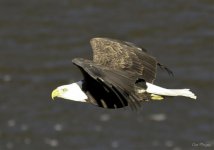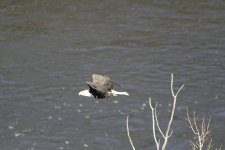CurtMorgan
Well-known member
I took this photo yesterday in full sun behind me and was greatly disappointed to see how badly the whites blew out. I have a Canon Rebel XT (350d) and was using my Canon 400mm f/5.6 on a tripod. Here is additional exif:
3456x2304, cropped 1136x796, exposure 1/1250 sec @ f/5.6, ISO 400
Here is info on my processing in lightroom (I am a self-taught novice on both lightroom and photoshop elements 6.0):highlight tones -31; light tones -33; temperature +4; clarity +22; vibrance +23; saturation +4; black clipping +16; exposure -.50; brightness -12; highlight tones +30; vignette midpoint -2.
I also converted to 8bit jpeg in photoshop and used neat image on the background 40%. I don't think that my camera will shoot RAW automatically, so unless the subject is still (in which case I switch to manual after noting the light reading in sport mode and adjust to that reading in manual/RAW) I usually use the sport mode which is a JPEG.
I will also include the original, converted to 8 bit, reduced a 1/3 in size, and compressed to jpeg.
3456x2304, cropped 1136x796, exposure 1/1250 sec @ f/5.6, ISO 400
Here is info on my processing in lightroom (I am a self-taught novice on both lightroom and photoshop elements 6.0):highlight tones -31; light tones -33; temperature +4; clarity +22; vibrance +23; saturation +4; black clipping +16; exposure -.50; brightness -12; highlight tones +30; vignette midpoint -2.
I also converted to 8bit jpeg in photoshop and used neat image on the background 40%. I don't think that my camera will shoot RAW automatically, so unless the subject is still (in which case I switch to manual after noting the light reading in sport mode and adjust to that reading in manual/RAW) I usually use the sport mode which is a JPEG.
I will also include the original, converted to 8 bit, reduced a 1/3 in size, and compressed to jpeg.





